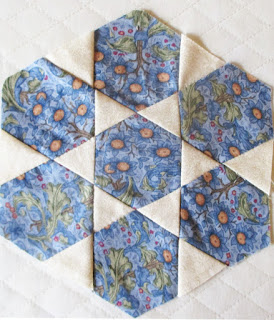Morris Hexagon 16: Hammersmith Terrace by Becky Brown
Hammersmith Terrace
Just two templates and only 19 pieces.
Hammersmith Terrace by Ilyse Moore
I named this week's hexie Hammersmith Terrace for the Georgian row house neighborhood which was the Morris family's London home after 1878.
They named their city house Kelmscott House after their country manor house. Both
overlook the Thames. Their town home at 8 Hammersmith Terrace is now a private residence but the William Morris Society is located in the Kelmscott House Museum nearby in the old coach house at 26 Upper Mall.
In an 1890 portrait of "The Art Socialists of London,"
The Cosmopolitan Magazine described the house:
"Mr. Morris lives during the greater part of the year at Hammersmith, a suburb lying six or seven miles southwest of London. The Thames, which takes a southerly bend at Chelsea, flows northward again at Hammersmith, nestles on this northern curve before the river, again descending, flows by Chiswick. His home, called Kelmscott House, a plain, wide brick structure, evidently of no very recent date, overlooks the river, from which it is separated only by the road and bank. In the rear the house opens upon a large garden pleasantly shaded with trees."
The pattern of two pieces, a triangle and a hexagon, is one of the few hexagon blocks you see in the 19th century.
A silk table cover, about 1885
Red setting triangles about 1900
The recently revealed Cosmati floor at Westminster Cathedral
Hammersmith Terrace by Bettina Havig
The pattern was published at least twice in the 1930s.
It's BlockBase #262.
Brilliant Star from Nancy Page
The syndicated Nancy Page column,
1934
Or Pointing Star
The Kansas City Star, 1936
Red triangles, about 1950
Pattern for an 8" Hexagon
(4" sides)
To Print:
- Create a word file or a new empty JPG file that is 8-1/2" x 11".
- Click on the image above.
- Right click on it and save it to your file.
- Print that file out 8-1/2" x 11". The hexagon should measure 4" on the sides.
- Adjust the printed page size if necessary.
- Add seams when you cut the fabric.
You get a similar effect with a slightly different geometry
of three pieces below. The center is of diamonds rather than a hexagon and triangles.
Double the triangle to get the diamond template.
BlockBase #263.3, the Hexagon Star from the Kansas City Star in 1940.
Hexagon Star by Mrs. H.D. Moore, Stevens County,
Minnesota, last quarter 19th century.
BlockBase #263, blocks set in a ring of long hexagons.
One More Inspiration
Fern's Through the Woods top, a variety of hexagonal blocks printed from Ink Lingo, a computer program with hundreds of hexagons.


































































